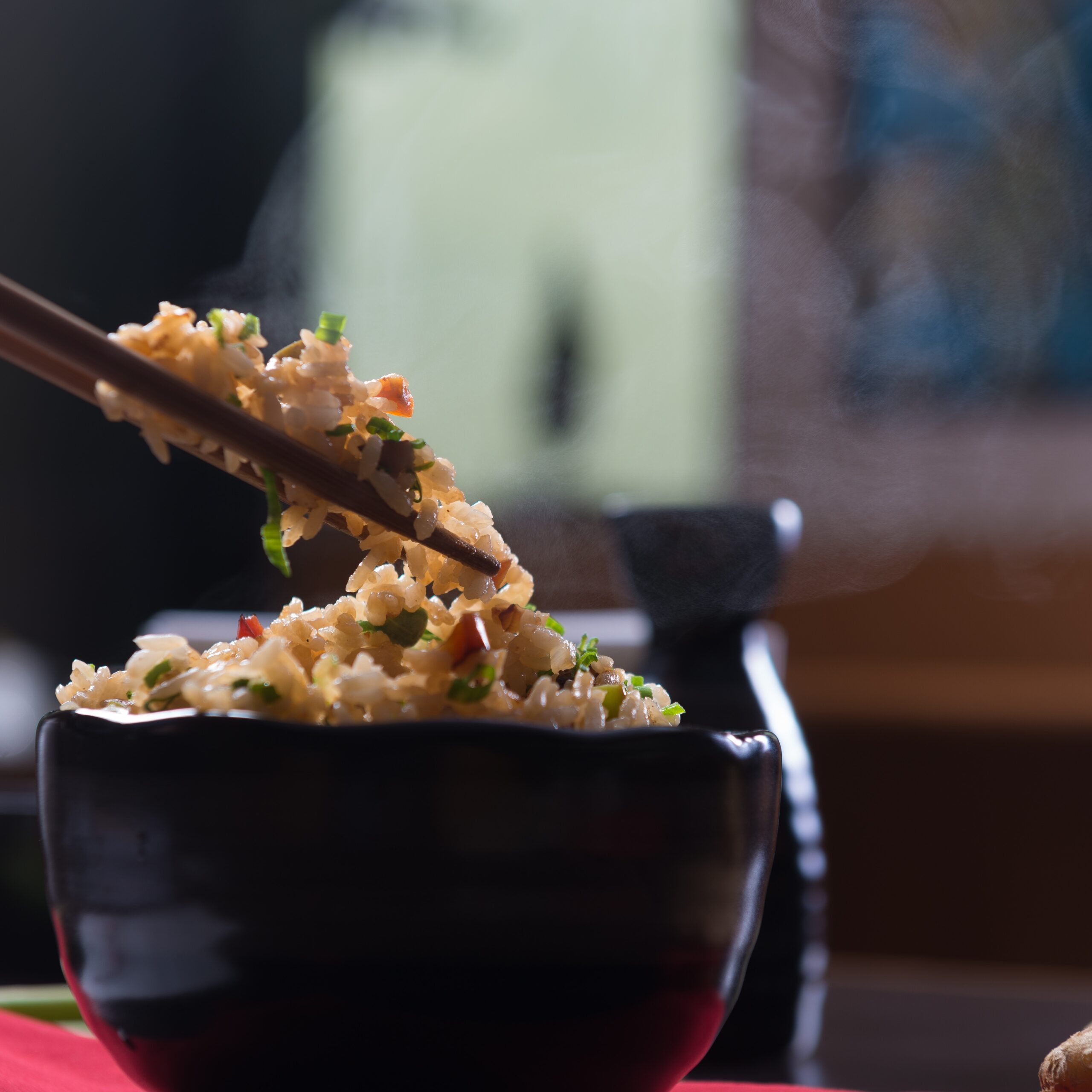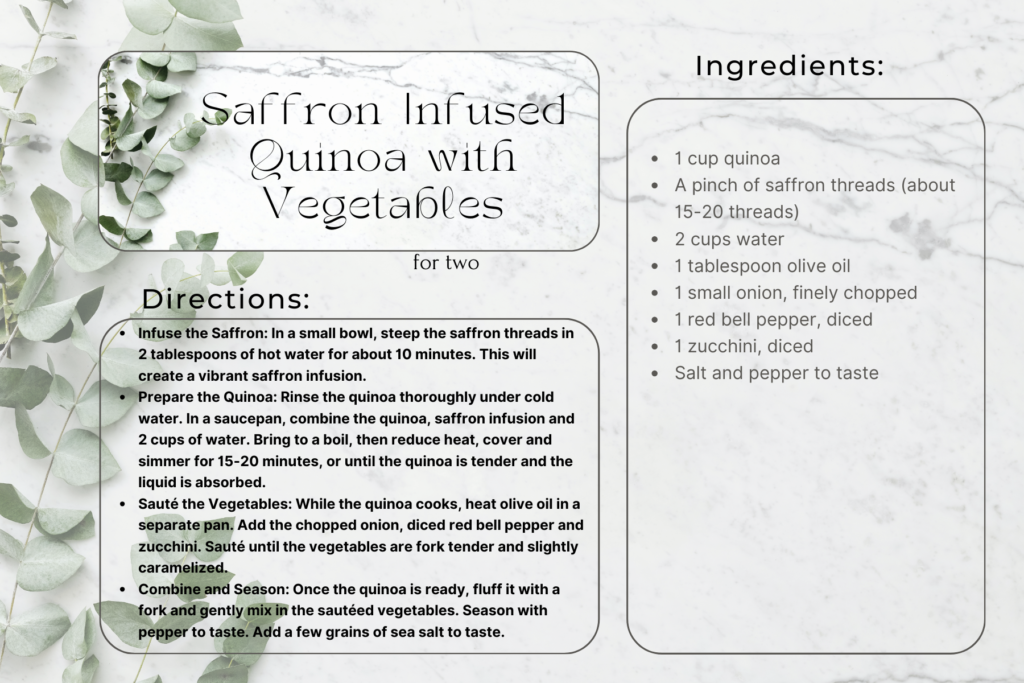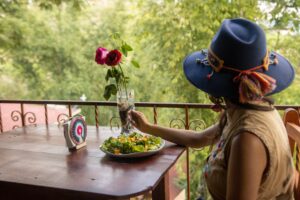Saffron Infused Quinoa with Vegetables is a great way to get some Saffron in your diet.
Ingredients:
1 cup quinoa
A pinch of saffron threads (about 15-20 threads)
2 cups water
1 tablespoon olive oil
1 small onion, finely chopped
1 red bell pepper, diced
1 zucchini, diced
Salt and pepper to taste
Instructions:
Infuse the Saffron: In a small bowl, steep the saffron threads in 2 tablespoons of hot water for about 10 minutes. This will create a vibrant saffron infusion.
The Art of Steeping Saffron
The art of steeping saffron involves coaxing out its rich flavors, vibrant color, and aromatic compounds. Here’s a step-by-step guide to mastering the saffron-steeping process:
Ingredients:
- Saffron threads (about 15-20 threads)
- Hot water (about 2 tablespoons)
Instructions:
- Prepare the Saffron Threads:
- Start with high-quality saffron threads. The quality of saffron significantly influences the flavor and color it imparts.
- Measure out the desired amount of saffron threads. Typically, a pinch (about 15-20 threads) is suitable for many recipes.
- Heat Water:
- Heat a small amount of water. It’s crucial to use hot, but not boiling, water to preserve the delicate flavors of saffron.
- The water temperature should be around 170 to 190 degrees Fahrenheit (77 to 88 degrees Celsius).
- Place Saffron in Water:
- In a small bowl or cup, place the saffron threads.
- Pour the hot water over the saffron threads. Ensure that all the threads are submerged in the water.
- Steep the Saffron:
- Let the saffron steep in the hot water for about 10 minutes. This allows the threads to release their color, aroma, and flavor into the liquid.
- During this time, you’ll notice the water transforming into a vibrant golden or reddish hue, depending on the type of saffron.
- Use the Saffron Infusion:
- Once the saffron has steeped, you’ll have a saffron infusion ready for use.
- Depending on the recipe, you can add the saffron infusion directly or mix it into other liquids for a more even distribution.
- Store Any Remaining Infusion:
- If you have leftover saffron infusion, it can be stored for a short period. Consider refrigerating it in an airtight container for a day or two.
Tips:
- Use a non-reactive container (glass or ceramic) to steep saffron to prevent any metallic taste.
- Crushing or grinding saffron threads slightly before steeping can enhance the release of flavor and color.
- Experiment with the amount of saffron and steeping time to achieve the desired intensity in your recipes.
Mastering the art of steeping saffron allows you to unlock its full potential, transforming your culinary creations into vibrant and flavorful delights.
Prepare the Quinoa: Rinse the quinoa thoroughly under cold water. In a saucepan, combine the quinoa, saffron infusion and 2 cups of water. Bring to a boil, then reduce heat, cover and simmer for 15-20 minutes, or until the quinoa is tender and the liquid is absorbed.
Sauté the Vegetables: While the quinoa cooks, heat olive oil in a separate pan. Add the chopped onion, diced red bell pepper and zucchini. Sauté until the vegetables are fork tender and slightly caramelized.
Combine and Season: Once the quinoa is ready, fluff it with a fork and gently mix in the sautéed vegetables. Season with pepper to taste. Add a few grains of sea salt to taste.
A Story of Saffron
The understanding of saffron’s benefits has deep historical roots. Ancient cultures, including the Greeks and Romans, believed in saffron’s medicinal properties. It was used not only as a spice but also as a remedy for various ailments. Centuries of traditional use have paved the way for modern research, revealing the potential cognitive and mood-enhancing effects of saffron that we appreciate today.
The historical use of saffron for its medicinal properties traces back thousands of years to ancient civilizations. In particular, the Greeks and Romans valued saffron not just as a spice to enhance the flavor of their dishes but also as a remedy for a range of health issues.
Saffron was utilized in traditional medicine to address conditions related to mood, digestion, and even as an aphrodisiac. The belief in its therapeutic benefits persisted through the ages, with saffron being considered a valuable and versatile substance.
The evolution of our understanding of saffron’s benefits is a fascinating journey from ancient traditions to contemporary research. While early cultures might not have had the scientific tools we have today, their observations and experiences laid the foundation for the exploration of saffron’s potential.
In recent times, modern scientific studies have substantiated some of the historical claims about saffron. Research suggests that saffron contains compounds with antioxidant, anti-inflammatory, and neuroprotective properties. These findings align with the historical use of saffron for cognitive function, mood enhancement, and overall well-being.
This convergence of historical wisdom and modern scientific validation highlights the enduring significance of saffron as a spice with not only culinary appeal but also potential health-promoting properties.
Saffron Infused Quinoa with Vegetables
Benefits for ADHD: This saffron-infused quinoa dish offers a nutritious and balanced meal. Quinoa provides complex carbohydrates for sustained energy, while saffron helps improve focus and cognitive function. (Read One Spice Everyone with ADHD Should Know About)
Benefits for Bipolar Disorder: Quinoa is rich in protein, which can aid in mood stabilization. Saffron’s potential mood-enhancing properties make this dish a valuable addition to a bipolar-friendly diet.
Benefits for RSD: The combination of quinoa and saffron promotes emotional balance. The sautéed vegetables add essential nutrients and fiber, supporting overall well-being.
A Few Cookbooks You might Want To Explore
Disclaimer: The information and/or products mentioned in this article are provided as information resources only and are not to be used or relied on to diagnose, treat, cure or prevent any disease. The statements made in this article have not been evaluated by the Food and Drug Administration. Any products mentioned are not intended to diagnose, treat, cure, or prevent any disease, but rather to be considered as an informational resource only to encourage critical thinking and personal research. The information in this article is intended for educational purposes only. The information is not intended to replace medical advice offered by licensed medical physicians. Please consult your doctor or health care practitioner for any and all medical advice.








